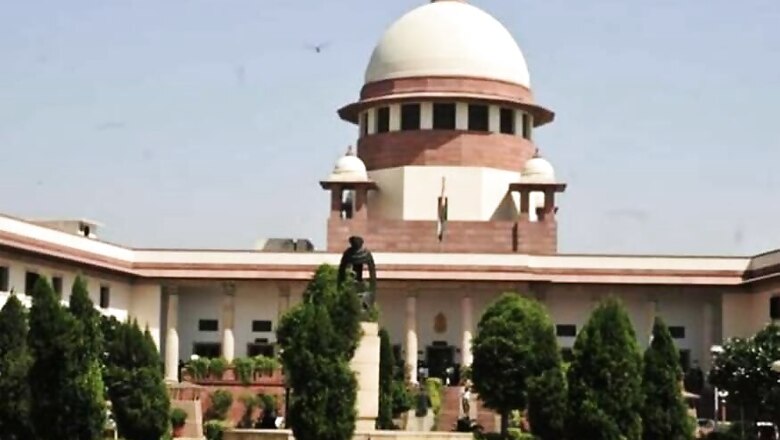
views
A transformation is underway in India’s court system. Led by the highest judiciary, this efficiency-inducing change in processes of courts such as filing, submitting extra material, payments of fees, verification practices or submissions has the potential to end the pain points of citizens while dealing with the court system.
While the system needed cleansing for decades, the matrix of change that has come following the COVID19 crisis is not merely revolutionary but worthy of emulation by governments (Union and States) in their process reforms across policing, healthcare, and other public services on the one hand and registrations, compliances and filings for businesses on the other.
From 15 May 2020, the Supreme Court has shifted to a new system of filing, while guidelines for High Courts and District Courts have been drafted, circulated but not yet implemented. Once all courts are plugged into this filing system powered by artificial intelligence and other technologies, India’s courts will be able to focus more on arguing for and delivering justice than on filings and paperwork.
Using a common base of technology, a process matrix design, and leading from the front by the Supreme Court, this is an ongoing creative disruption in India’s justice system. This system uses electronic filing (e-filing) as a process tool and artificial intelligence as a reference support infrastructure, both underlined by efficiency, transparency and access to every user of court-delivery services. In other words, India’s courts are ushering in a new future-ready justice dispensation system for a 21st century India.
It also shows that the courts are in tune with and working towards developing a new filing architecture that’s in tune with a modern India. On the technological front, this is a future has already happened. COVID19 tipped the scales and pulled back the timeline. Led by Justice Dhananjaya Y. Chandrachud, Chairman of the Supreme Court’s eCommittee that has ushered in these process reforms and Chief Justice of India Sharad A. Bobde under whose leadership they have been sealed, India’s courts are now plugged into this future.
Two documents, “e-Filing – User Manual” for the Supreme Court and “A Step by Step Guide for Efiling for High Courts and District Courts of India” define the details of what can be termed as process reforms in the judicial system. The driving force behind these changes are “TEST values” – Trust, Empathy, Sustainability and Transparency. While the acronym is interesting, it will be tested by time. Of the four transparency in judicial processes is here, sustainability will need to be seen over the years, empathy is too fuzzy an idea for process reforms, while trust in the system will have to be earned.
The system enables electronic filing of legal papers for civil and criminal cases across courts. This will promote paperless filing and processing, while creating time and cost saving efficiencies. The system can be used by any Advocate-on-Record enrolled to practice in the Supreme Court of India or any or Party-in-Person litigant registered with the e-filing system. For High Courts and District Courts, the system is targeted at advocates, to whom the idea is being sold as a “Digital Era Advocate”. Some High Courts, such as the Delhi High Court has allowed Party-in-Person, while others are watching in the wings.
Four key features define this system. First, the system enables 24/7 filing. Members of the bar do not have to file their cases during court hours; they can do so from home at any time, on any day. Second, it enables online communication of defects and scrutiny of matters that are filed. The system has time slots for raising the defects and seeking rectification. Third, e-payment of court fees. And fourth, introducing the digital signature for all filing-related conversations.
All four required lawyers or their clerks to stand in lines, over several counters, often standing on the knife-edge of case and process timeslots, causing delays through serial hearings in the dispensation of justice. With the new system all these are gone. Finally, for those who are not in tune with technology, the Registry Service will hand-hold them by engaging data entry operators in the Supreme Court, a system that could be used by High Courts and District Courts as and when they follow.
The artificial intelligence infrastructure on which this process speeding rests will now play a big role in the organisation of courts, categorisation of matters, process automation. It will also enable extraction of information at the rate of 1 million words per minute and can be used for the purpose of deciding a case. There is visible enthusiasm around these changes at the top. “If we had this system when the Ayodhya matter was being heard, I don’t know how fast we could have dealt with it,” Bobde said while releasing the document. “Records of thousands and thousands of pages, information from that could be extracted in a minute.”
In January 2020, around 1 lakh cases comprising approximately 26.84 lakh pages were transmitted from district courts to High Courts in India. This waste will now end and from the clients’ side, the reduction of paperwork will cut cost. The process behind the change has been tested – during the lockdown period, there were 820 matters and 552 documents filed via e-filing in the Patna High Court alone. Further, if matters are introduced in courts through e-filings, and a case is decided by trial court, the appellate court can access the entire record of the trial court along with the appeal.
The lockdown can be seen as a practice session, a compulsory training to prepare for a new working environment. Along with hearings through video-conferencing, this process reform will go a long way in sharpening the justice system, tightening costs and reducing the financial burden of justice on citizens. But it is not that all cases can or will be heard on video. Some will have to be heard in congregation.
There will be the usual protests. Clerks, for instance, will need to upgrade their skills. Thus far, their job was akin to courier firms – carting cases, taking photocopies, paying fees, and suchlike. With the entire system now online and available to every Advocate-on-Record at a tap, these skills have lost their purpose. Clerks will now have to upgrade, adapt, add value to themselves and become executive assistants. The entire bulk photocopying infrastructure and filing of paper books in courts will need to find new sources of revenue. This huge number of staff undertaking these tasks will have to embed itself into the new system – being part government servants their jobs are secure even if their tasks may change. As far as petty rent-seeking and bribery goes, it will hopefully end.
If we hear cries against this proposal, we only need to lean on the towers of history. For every change, leave alone a reform, there have been doomsday pictures painted by incumbents. When banks were computerised in the 1980s, banking unions raised a big hue and cry saying computerisation will displace jobs. But finally they upgraded themselves and settled into related jobs. As with every new system, the e-filing infrastructure too will face glitches. But those seeking a U-turn at the first challenge are going to be disappointed. While problems, as and when they come up, will be ironed out, there is no going back on this step, according to Bobde.
It is clear that riding these process reforms, India can expect speedier justice. And if that happens, the clogging of cases in courts could end. This will particularly help those with fewer resources – poor citizens, small and medium enterprises, low-cost contractual breaches, property disputes. The courts may see fewer people, as lawyers and litigants may not have to be physically present there.
And while the future direction of the court systems is clear, the past need not stand on an archaic platform. The Supreme Court should initiate a simultaneous process under which the process of digitising, in machine-readable form, should be initiated for old cases. This may take time, it may need resources. But it will complete the circle of justice the Supreme Court intends to draw.
A big challenge may come from judges themselves. The transition to reading and engaging with e-documents from paper ones, for instance, may not be as easy as planned. Referring multiple pages across varying courts will need the judges to adapt and learn new skills too. But the decisive and irreversible action combined with the efficiency-inducing intention of the change being clear, the benefits are likely to override these costs and inconveniences.
The returns from this initiative should be visible in the short-term, while outcomes such as reduced pendency should follow in the medium- to long-term timespan. While the transition could take some time before it stabilises, the vision of, and path to, paperless, efficient, AI-driven, technology-supported courts has been ushered in and action plan drawn up. With full credit and kudos to the Supreme Court for this initiative, the nation watches closely how the new system shapes up, and in turn shapes the justice system to serve a 21st century India.
The article first appeared in ORF.


















Comments
0 comment